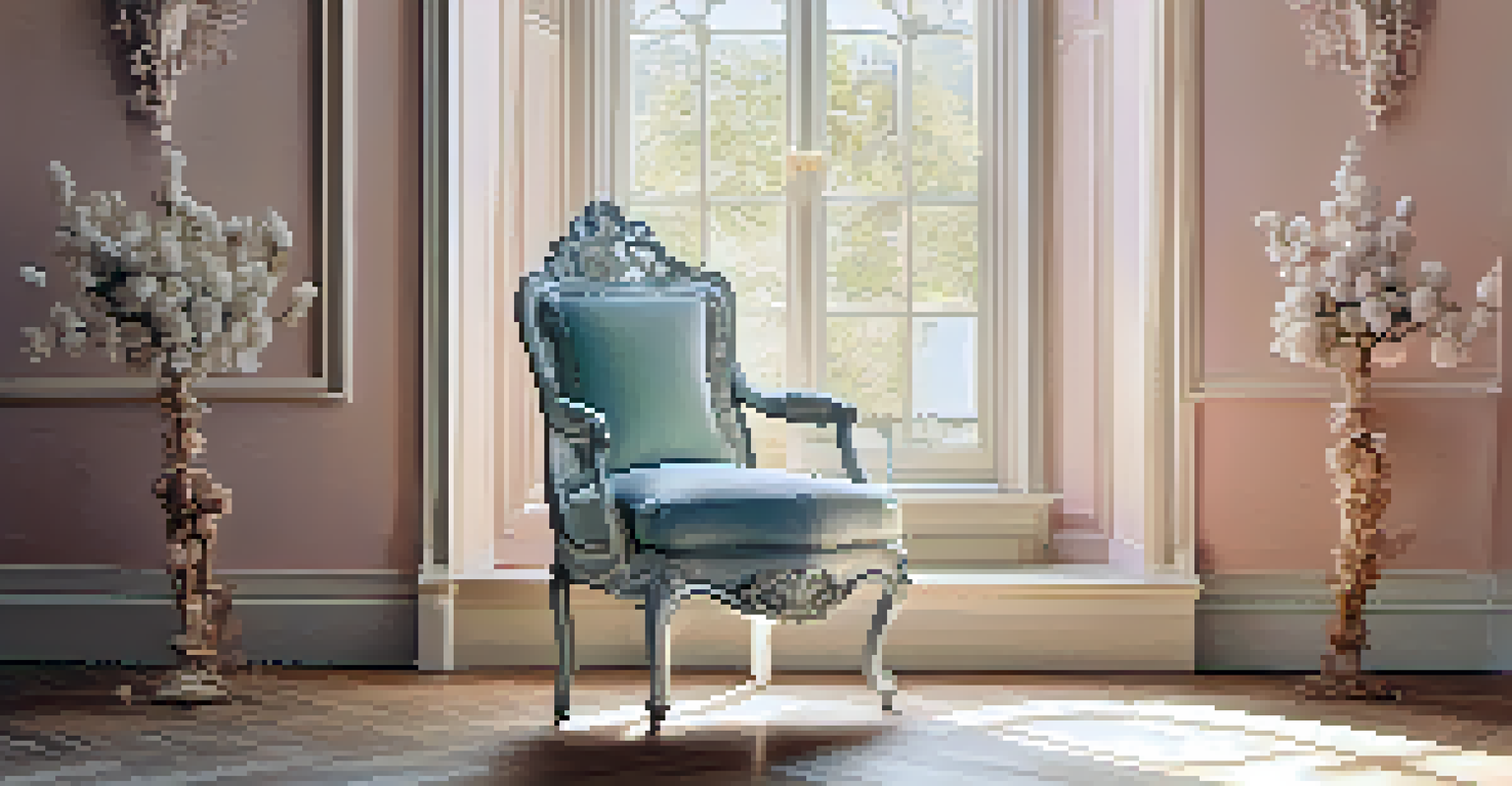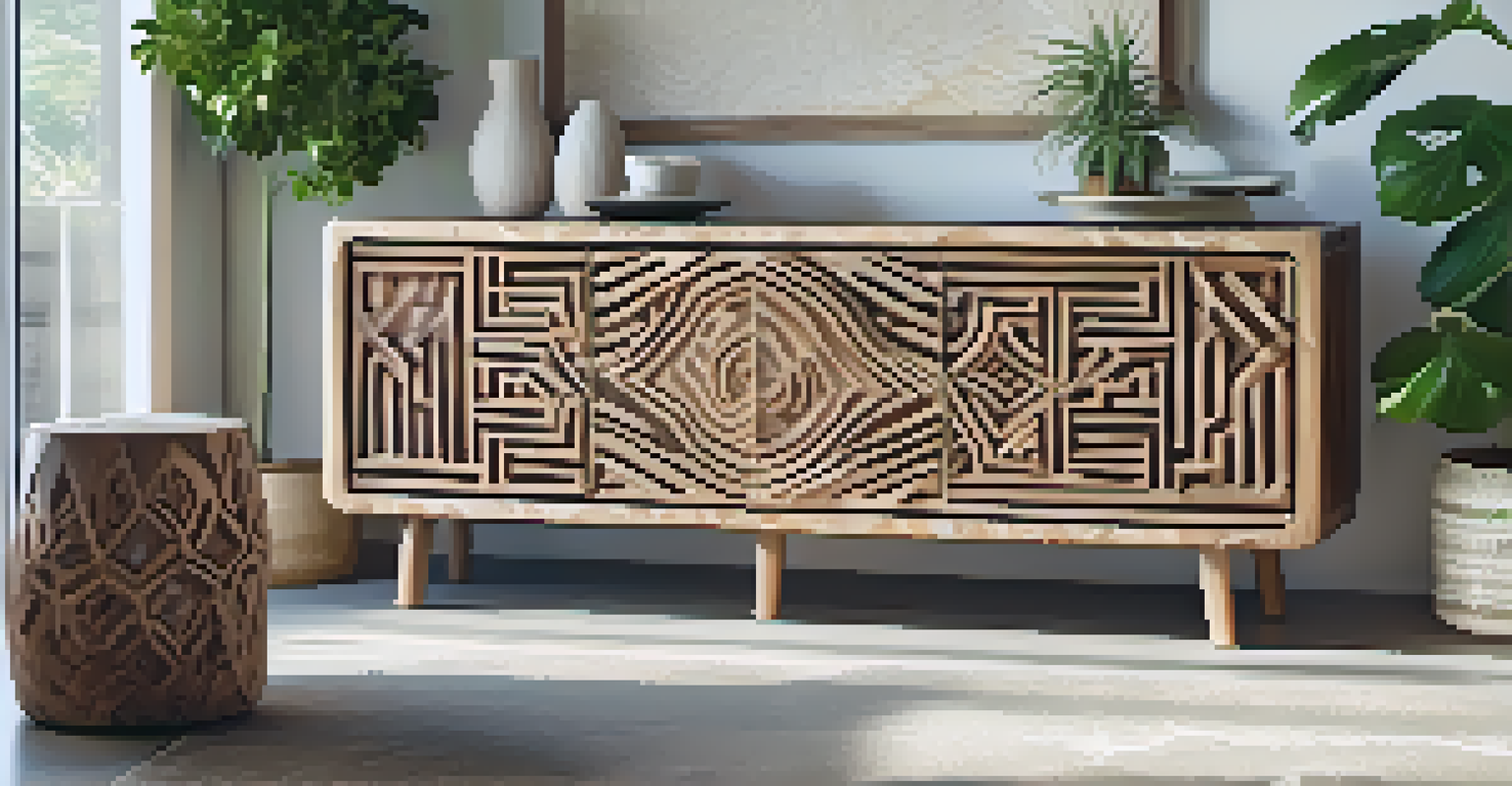The Evolution of Carved Furniture Design Through History

Understanding the Origins of Carved Furniture Design
Carved furniture design dates back thousands of years, originating in ancient civilizations such as Egypt and Mesopotamia. These early artisans used wood, ivory, and stone to create functional yet decorative pieces, reflecting the culture and values of their time. The craftsmanship was not just about utility; it conveyed social status and artistic expression.
The details are not the details. They make the design.
As trade routes expanded, influences from different cultures began to blend, leading to unique styles in carved furniture. For instance, the intricate designs seen in Middle Eastern furniture showcased geometric patterns and floral motifs, which were often symbolic. This cross-cultural exchange enriched the art of furniture making, making it a tapestry of various traditions.
The use of carving techniques evolved, with artisans developing methods like relief carving and inlay work. These advancements allowed for more elaborate designs, creating pieces that were not only functional but also works of art that told stories of their creators and the societies they represented.
The Impact of the Middle Ages on Furniture Carving
During the Middle Ages, the need for sturdy furniture led to a shift in design focus towards functionality. However, this period also saw the emergence of Gothic styles, characterized by intricate carvings that adorned everything from chests to chairs. The pointed arches and elaborate detailing reflected the architectural trends of the time, making furniture an extension of the structures they inhabited.

Craftsmen began to incorporate religious themes into their carvings, often depicting biblical scenes or saints. This not only served a decorative purpose but also reflected the spiritual beliefs of the society. As a result, furniture became a medium for storytelling and cultural expression.
Carved Furniture's Rich History
Carved furniture design has evolved through various historical periods, reflecting cultural values and artistic expression.
Despite the emphasis on durability, the beauty of carved details remained important. The interplay of form and function in medieval furniture laid the groundwork for future styles, showing that even in practical designs, artistry could thrive.
Renaissance: A Flourishing of Carved Furniture Design
The Renaissance marked a significant turning point in carved furniture design, as artists drew inspiration from classical antiquity. This revival of interest in ancient Greece and Rome led to the incorporation of symmetry, proportion, and perspective into furniture styles. Carved details became more elaborate, often featuring mythological figures and intricate foliage.
Design is not just what it looks like and feels like. Design is how it works.
Wealthy patrons sought furniture that showcased their status, leading to the creation of grand pieces like the cassone, a decorative chest typically adorned with elaborate carvings. These pieces not only served practical purposes but also acted as symbols of wealth and prestige, often passed down through generations.
This period also saw the rise of professional guilds, which established standards for craftsmanship and design. The emphasis on quality and artistry during the Renaissance laid the foundation for the future of carved furniture, influencing styles in the centuries to come.
Baroque and Rococo: Ornate Carvings Take Center Stage
The Baroque period introduced a dramatic flair to carved furniture design, characterized by bold forms and ornate details. Furniture became more than just functional objects; they were statement pieces, often featuring extravagant curves and intricate carvings that evoked a sense of grandeur. The use of rich materials, such as mahogany and gilded accents, further emphasized this opulence.
As the Baroque style transitioned into the Rococo, the focus shifted to elegance and playfulness. Rococo furniture often featured asymmetrical designs and softer, more fluid lines, with carvings that depicted nature and romantic themes. This lightness and whimsy made furniture feel more approachable and personal, contrasting the heavier Baroque style.
Impact of Industrial Revolution
The Industrial Revolution shifted furniture production to mass manufacturing, prompting a revival of handcrafted carved designs.
Both styles mirrored the changing social dynamics of their time, where the rising middle class began to seek out beautifully crafted pieces for their homes. The emphasis on ornate carvings during these periods reflected not only artistic trends but also the cultural shifts that influenced furniture design.
The Industrial Revolution and Its Effect on Carved Furniture
The Industrial Revolution brought about significant changes in furniture production, shifting from handcrafted pieces to mass production. While this made furniture more accessible, it also posed a challenge to traditional carving techniques. Many artisans found it difficult to compete with the speed and cost of machine-made furniture, leading to a decline in intricate carving practices.
However, this period also sparked a revival of interest in craftsmanship through movements like the Arts and Crafts movement. Advocates of this movement emphasized the value of handmade items, leading to a resurgence of carved furniture that celebrated traditional techniques. Craftsmen began to merge functionality with artistry, creating pieces that were both beautiful and practical.
The contrast between mass-produced furniture and handcrafted pieces highlighted the uniqueness of carved designs, leading consumers to appreciate the artistry behind each piece. This era underscored the importance of preserving traditional carving methods, even as new technologies emerged.
Modern Influences on Carved Furniture Design
In recent years, carved furniture design has continued to evolve, influenced by modern aesthetics and sustainable practices. Designers are now blending traditional carving techniques with contemporary styles, bringing a fresh perspective to classic designs. This fusion allows for innovative pieces that maintain the beauty of carved details while appealing to modern sensibilities.
Sustainability has also become a key factor in furniture design, with an increasing emphasis on using reclaimed wood and eco-friendly materials. This focus not only honors the craftsmanship of the past but also addresses contemporary environmental concerns. Carved furniture is now being designed with a conscience, marrying artistry with responsibility.
Future Trends in Carved Design
The future of carved furniture design embraces diverse influences and customization, merging traditional techniques with modern aesthetics.
Additionally, technology has opened new avenues for creativity in carving. CNC machines, for example, can replicate intricate designs with precision, allowing artisans to experiment with new patterns and styles. This blend of traditional and modern techniques ensures that the art of carved furniture continues to thrive in today's world.
The Future of Carved Furniture Design
As we look to the future, carved furniture design is set to embrace even more diverse influences. Globalization has made it easier for designers to draw inspiration from various cultures, leading to a richer tapestry of styles and techniques. This cross-pollination of ideas will likely result in innovative designs that reflect our interconnected world.
Furthermore, the growing trend of customization in furniture allows consumers to seek unique pieces that resonate with their personal style. Artisans are increasingly creating bespoke items that feature custom carvings, ensuring that every piece tells a unique story. This personalization is a testament to the enduring appeal of carved furniture.

In essence, the future of carved furniture design holds exciting possibilities, balancing tradition with innovation. As artisans continue to push the boundaries of creativity while honoring age-old techniques, carved furniture will remain a cherished aspect of interior design for generations to come.